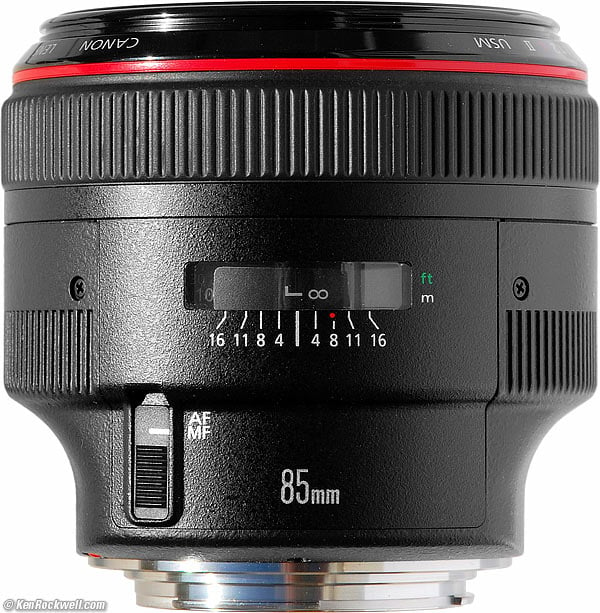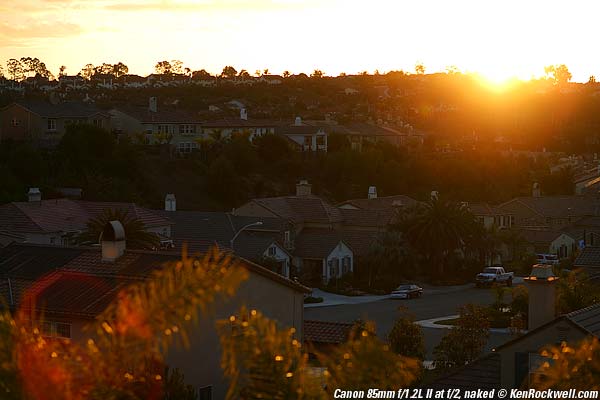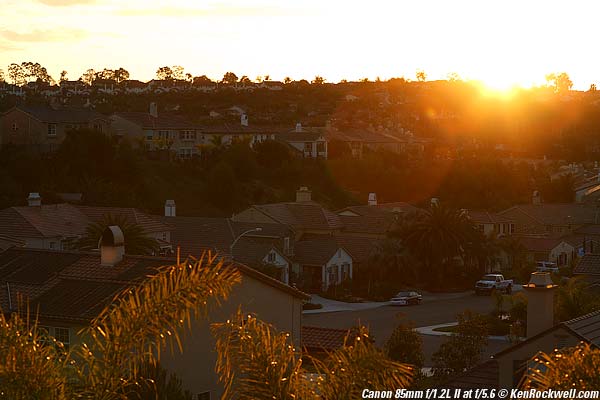Canon 85mm f/1.2L II
© 2013
KenRockwell.com. All rights reserved.
Top Introduction Specs Performance Recommendations
Canon EF 85mm f/1.2L II USM. enlarge. I'd get mine at Adorama or at Amazon.
November 2013 Canon Reviews Canon Lenses All Reviews
(Continued from previous page)
Top Introduction Specs Performance Recommendations
35mm Cameras, use on back to Performance or back to Introduction.
It works great; live it up.
Filter, use with back to Performance or back to Introduction.
Canon goofed slightly and designed it with a 72mm thread, not the standard 77mm thread to accept the filters used by pros.
This isn't that much of a problem because:
a.) This special lens is for use in darkness where we're gasping for every last photon, so the only filter likely to be used is for protection, and
b.) If I owned one of these beasts and intended to use my usual filters with it, I'd pop a 72mm - 77mm step-up ring on it and treat it forever more as a 77mm lens. The hood would no longer fit with this setup, but I don't use hoods. To confuse you more, this lens is one of the few I would suggest using with its included hood.
Any thick filter works great on it, even stacked. The worse thing that will happen with stacked filters is a slight increase in falloff wide-open. Stop down to f/2 or smaller and that falloff goes away. This ought not be a problem, since if it's dark enough to be using f/1.2 you're probably not using three stacked filters; and if you're using f/1.2 for background separation, you'll possibly like any additional falloff to concentrate attention on your model Try it and see, this lens doesn't have any problem with multiple filters. If you do, using 77mm filters and a step up ring helps.
Flare and ghosts back to Performance or back to Introduction.
The f/1.2L II isn't quite good as the Canon 85mm f/1.8 with the sun in the image.
The f/1.2L II is also more susceptible to flare from light outside the image than other lenses. I got flare shooting indoors with a subject in shadow near an open window. Use the included hood; I didn't. Use the hood and the flare caused by sources outside the image should go away.
At f/2. Roll mouse over image to compare to 85mm f/1.8.
Here's a fast comparison at f/2. (The sky gets darker with the f/1.8 because of its greater relative falloff at f/2.) The Canon 85mm f/1.2 has a ghost in the bottom left; the 85mm f/1.8 doesn't. I even handicapped the 85mm f/1.8 with a multicoated filter while the 85mm f/1.2 ran naked.
At f/5.6 there's a large ghost of the diaphragm in the f/1.2, mostly absent in the f/1.8 version:
At f/5.6. Roll mouse over image to compare to 85mm f/1.8 (no filters this time).
Good news: the flare and ghosts of this Canon 85mm f/1.2L don't change with the use of a multicoated filter. Don't worry about using a filter. I haven't compared that here.
Ghosts aren't much of an issue. I just wanted to compare which lens was better, and the inexpensive f/1.8 version is better. This is another way in which you pay for the f/1.2 speed.
Don't worry: I never saw any ghosts with any real image worth photographing, although I did see flare indoors when not using the included hood.
Flash, use with back to Performance or back to Introduction.
Not that you'd want to use it with this lens, but the tiny flash of my Rebel XTi easily clears the 85mm f/1.2.
It lights the entire subject, even at the closest focus distance.
Macro back to Performance or back to Introduction.
The Canon 85mm f/1.2 is your worst choice for macro. Its optics are optimized for insane sharpness at reasonable distances, so it doesn't focus very close. The Canon 85mm f/1.2 is a special purpose lens, and macro isn't that purpose.
That said, here's how it looks at it's closest focus distance on my full-frame 5D. It will get proportionally tighter with 1.3x and 1.6x cameras (see Crop Factor).
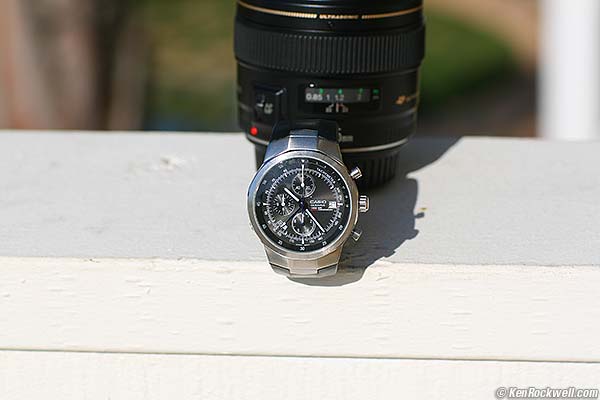
At closest focus at f/5.6, full image from my full-frame Canon 5D.
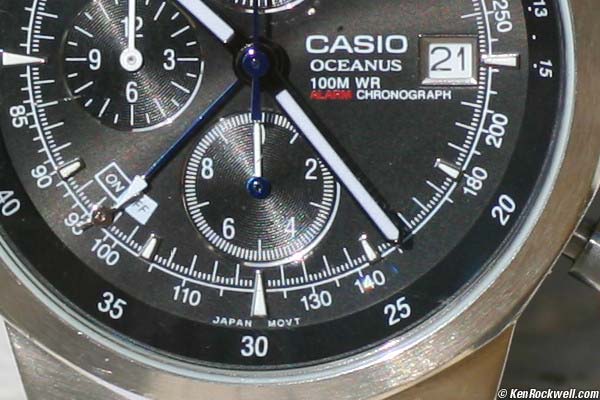
Crop from above image at 100%, no extra sharpening.
It's not very close, but at least its reasonably sharp.
The $100 Canon 18-55mm EF-S lens on a Rebel gets much, much closer, and if you want macro, the Canon 100mm f/2.8 macro is superb.
Serial Number back to Performance or back to Introduction.
The serial number is engraved into the metal lens mount and filled in black paint.
You must remove the lens from the camera, or remove the rear cap, to see it.
Sharpness back to Performance or back to Introduction.
Sharpness is exquisite. The only limits are its nonexistent depth of field at f/1.2 and how accurately you and your camera can focus. If you're off by a micron (a wavelength of light) at the image plane, you lose sharpness.
Astronomers will love this lens! Journalists won't care, because all the sharpness is lost from the limited depth of field when shooting anything alive or three-dimensional at f/1.2.
This lens is virtually flawless. Your technique is your only barrier to sharpness. I have a page on How to Get Sharp Photos.
These letters correspond to center - side - far corner. Possible ratings are E - VG - G - F - P. These are subjective. Don't fret over differences between adjacent grades.
I only bothered to publish the results up to f/4. As you can see, as of f/2, it's as sharp as it can get, and the only thing limiting sharpness at smaller apertures is diffraction. See also How Sharpness Varies with Aperture.
On my Canon 5D (full-frame)
f/1.2 |
f/1.4 |
f/2 |
f/2.8 |
f/4 |
VG - VG - VG |
E - E - VG |
E - E - E |
E - E - E |
E - E - E- Etc. |
It's so good I just have to show you it. Here's the full-frame image from my 5D at f/1.2 for reference.
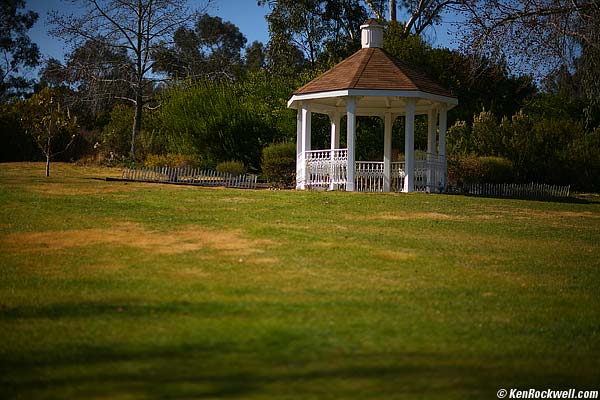
Full frame image, Canon 85mm f/1.2 at f/1.2.
Since the falloff is obvious (only an idiot shoots at f/1.2 in daylight where you'd see this), here it is at f/2:
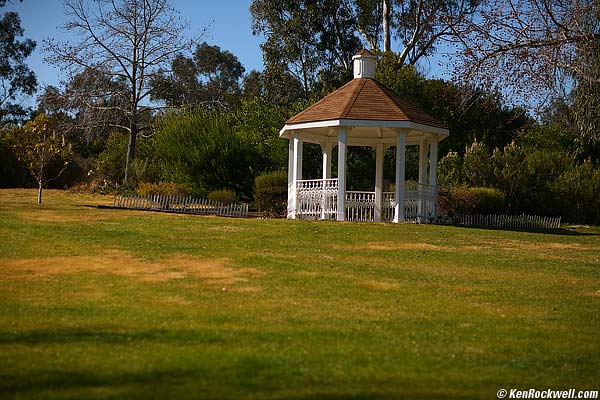
Full frame image, Canon 85mm f/1.2 at f/2.
And here it is at f/2.8:
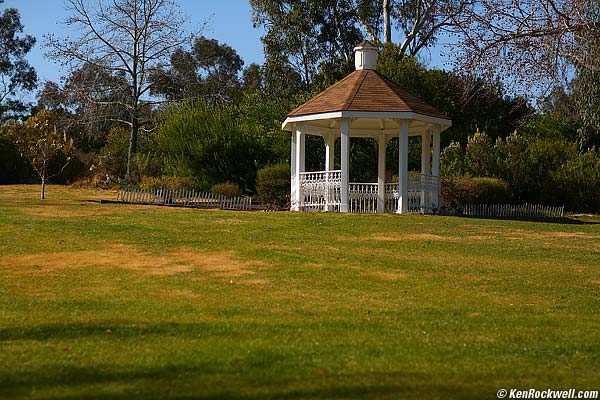
Full frame image, Canon 85mm f/1.2 at f/2.8.
Here's how sharp it is at 100% on my 5D:
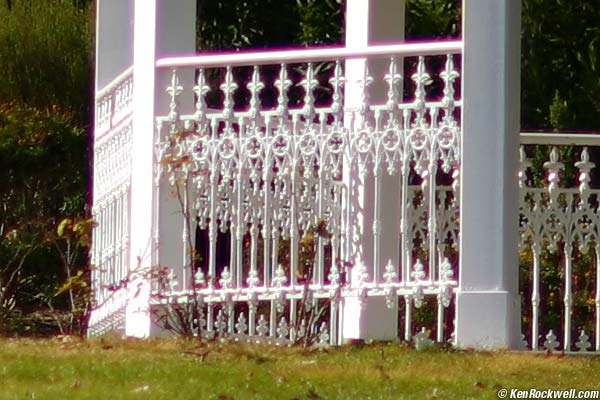
At f/1.2, focused behind subject (look to right), crop from 100% image.
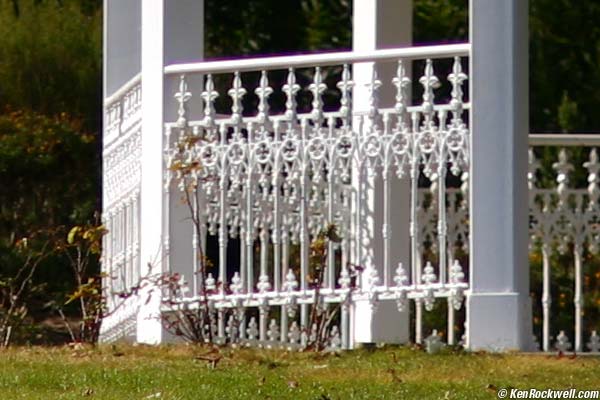
At f/1.2, focused in front of subject (look at grass), crop from 100% image.

At f/2, focused behind subject, crop from 100% image.
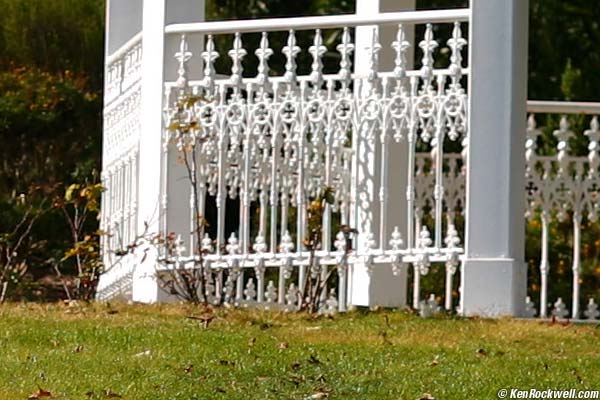
At f/2, focused in front of subject (look at grass), crop from 100% image.
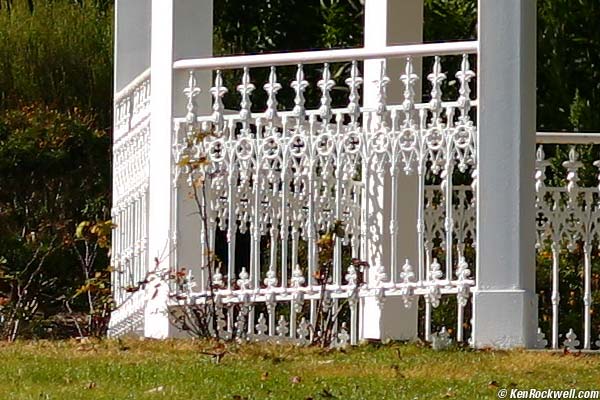
Aha, good focus! Canon 85mm f/1.2 at f/2.8, Crop from 100% image.
Sharpness Discussion: I told you focus was everything. These shots are at 100 feet (30m), and it is very difficult to nail perfect focus if you're shooting tests at f/1.2.
If the focus falls behind the subject you get a little magenta smear from highlights. Note how the rear part of the gazebo is much sharper in those shots.
If the focus falls in front of the subject it gets a little softer and loses the magenta halos. Note how much sharper the grass is in these shots.
I finally got it dead-on in the f/2.8 shot, whoo hoo! Other shots of less photogenic subjects were as sharp at f/1.2 as at f/2.8, but too ugly to share here.
The AF system in my 5D consistently focuses very slightly in front of the subject, not noticeable during proper photography. The way around that is to:
a.) Shoot properly (not at f/1.2 in daylight), or
b.) Have my 5D properly calibrated (Canon would probably do it for free under warrantee), or
c.) Learn your camera's calibration, and focus on something at a slightly different distance than your intended subject. That's what I did here.
The Sharpness Money Shot
Here's the only image I need to show, at least to the cognoscenti, that this lens is insanely sharp. This is a crop of the farthest top right corner of the 5D images above at 100% at f/1.2:
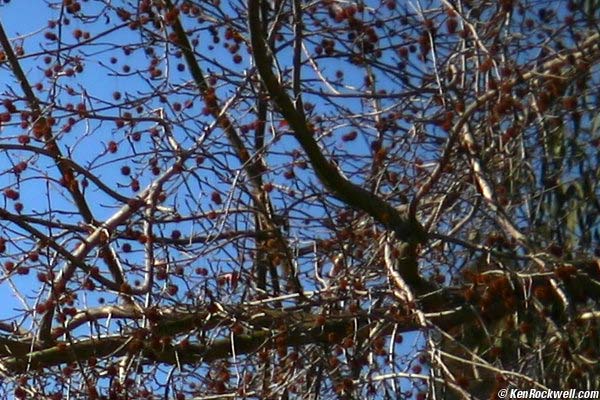
Canon 85mm f/1.2 at f/1.2, Crop from farthest top right corner of 100% 5D image.
As we say in science, Holy Crap! The noise you may see buzzing around the branches are JPG artifacts from my 5D. What you see in this unsharpened crop is a sharp image. There is no veiling from spherical aberration, no color fringes from chromatic aberration and no nothing except a sharp image. No other lens I've ever used can do this at full aperture. Every other lens softens, smears, and does all sorts of nasty things in the far corner wide open.
For the great majority of you who aren't cognoscenti, for comparison here are crops from 100% images from my D200 from a Zeiss 50mm f/1.4 at f/1.4. It's not at f/1.2, but f/1.4, and it's not from a full-frame corner, but from halfway between center and corner:
Zeiss 50mm f/1.4 at f/1.4. Roll mouse over to see it at f/5.6.
This is typical performance for a conventional, non-aspherical, lens. See all the haze? It's not haze; its a serious lens aberation called spherical aberation. It makes fast lenses look hazy, but sharp, wide open, and it's why some people pay the big bucks for aspherical lenses like this Canon. This Canon has no spherical aberation, which means none of this haziness wide open.
Now do you realize how insanly sharp this Canon 85mm f/1.2L II is? This Canon is as sharp at f/1.2 in the corner as the Zeiss is at f/5.6, and the Zeiss has obvious color fringes at f/5.6 while the Canon has none. The Zeiss' color fringes are covered up by the haze (spherical aberration) at f/1.4.
The only limits to what this Canon lens can do is you, your subject, and how well you and your camera can focus. To get this sharp corner I had to use a different frame, focused for the tree which was at a different distance than the gazebo.
The Canon 85mm f/1.2L II USM has a flat field. I confirmed this on shots of the horizon from a mountain, tilted to run the horizon with trees from corner to corner. Wow.
Sunstars back to Performance or back to Introduction.
You're going to point this at the sun? Don't do it!
The 8-bladed diaphragm can give 8-pointed stars on brilliant highlights.
back to Performance or back to Introduction.
This Canon 85mm f/1.2L has no image stabilization, but it's so heavy that my iron grip gives great results anyway.
Here are the percentage of sharp shots that I get at each speed:
1 |
1/2 |
1/4 |
1/8 |
1/15 |
1/30 |
1/60 |
1/125 |
0 |
0 |
5 |
15 |
50 |
66 |
85 |
100 |
Let's calculate how a marketing department would claim that this lens improves on hand-holding, as they do with lenses that have IS.
Marketing departments hope you believe that the slowest you could hold this lens is at 1/80, which is the old wives tale of 1/focal length. If you believe that, and seeing how I get perfectly sharp results 50% of the time at 1/15, that means I get an improvement of 2-1/3 stops over hand holding! Make little sense? It's not supposed to - marketing departments often lie about the improvements made with IS systems, which is OK because IS is so important.
This is called Lying with Statistics, and that's par for the course for marketing departments.
Slowest Sharp Speed at 50% |
Marketing Stops Improvement |
1/15 |
2-1/3 |
TIP: In dim light, fire several shots in the continuous shutter mode and pick the sharpest later. Blur is a random event, so if you fire enough shots, you'll eventually get a sharp one even at slower speeds!
See also Why IS is Important.
Focal Length Encoding Accuracy
The EXIF data says 85mm as expected.
Top Introduction Specs Performance
As I said pages ago, the people who need this know who they are. This is a very special purpose lens. It's extraordinarily sharp at f/1.2 and every reasonable aperture, but you pay for it compared to the f/1.8 version in cash, size, weight, focus speed, focus ease, ghosts and close focus distance.
If you want a super-sharp short tele lens for general photography, get the Canon 85mm f/1.8 which I've reviewed in parallel to this f/1.2, but still need to write up for you folks.
The people who need this lens, journalists and astronomers, will love it. Journalists will appreciate the improvement in focusing over the previous version which was even klunkier, and of course love and use f/1.2 for sucking every last photon out of the dark.
Astronomers will love the extraordinary optics, especially at f/1.2 where they shoot it. They'll appreciate the flat field and complete lack of coma or other aberrations wide-open for star images. There isn't any need to stop down for sharpness, except to counter corner darkening. As those clever astronomers know, they can compensate for the corners.
I don't see a DxO module for this lens, but hear one just became available. DxO will completely eliminate the light falloff at f/1.2. No one else cares - when you shoot at f/1.2 in the dark, you want the emphasis to be the center of the frame to exclude any junk on the sides of the composition.
Help me help you top
I support my growing family through this website, as crazy as it might seem.
The biggest help is when you use any of these links when you get anything, regardless of the country in which you live. It costs you nothing, and is this site's, and thus my family's, biggest source of support. These places have the best prices and service, which is why I've used them since before this website existed. I recommend them all personally.
If you find this page as helpful as a book you might have had to buy or a workshop you may have had to take, feel free to help me continue helping everyone.
If you've gotten your gear through one of my links or helped otherwise, you're family. It's great people like you who allow me to keep adding to this site full-time. Thanks!
If you haven't helped yet, please do, and consider helping me with a gift of $5.00.
As this page is copyrighted and formally registered, it is unlawful to make copies, especially in the form of printouts for personal use. If you wish to make a printout for personal use, you are granted one-time permission only if you PayPal me $5.00 per printout or part thereof. Thank you!
Thanks for reading!
Mr. & Mrs. Ken Rockwell, Ryan and Katie.
Home Donate New Search Gallery Reviews How-To Books Links Workshops About Contact

